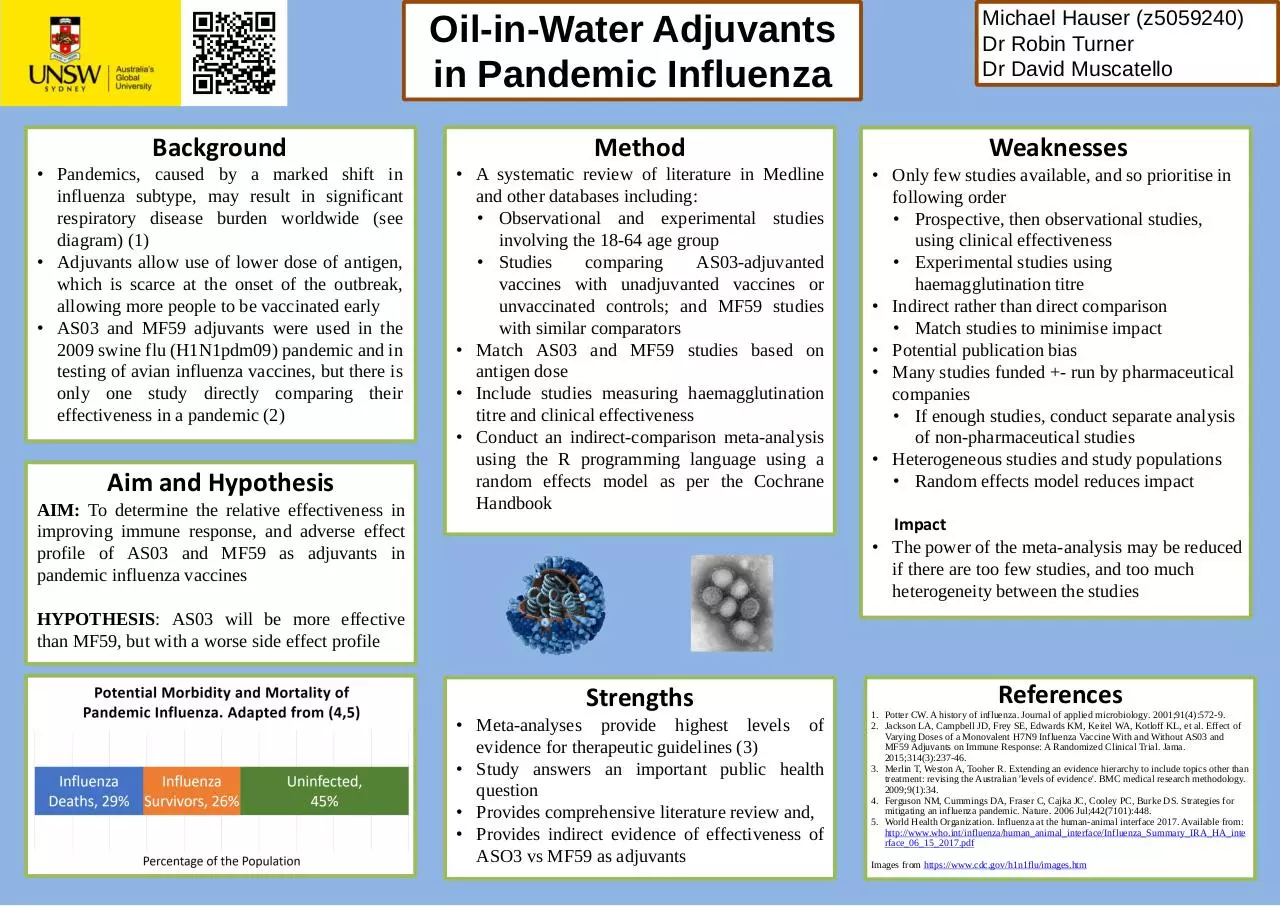z5059240 poster (PDF)

File preview
Oil-in-Water Adjuvants
in Pandemic Influenza
Michael Hauser (z5059240)
Dr Robin Turner
Dr David Muscatello
Background
Method
Weaknesses
• Pandemics, caused by a marked shift in
influenza subtype, may result in significant
respiratory disease burden worldwide (see
diagram) (1)
• Adjuvants allow use of lower dose of antigen,
which is scarce at the onset of the outbreak,
allowing more people to be vaccinated early
• AS03 and MF59 adjuvants were used in the
2009 swine flu (H1N1pdm09) pandemic and in
testing of avian influenza vaccines, but there is
only one study directly comparing their
effectiveness in a pandemic (2)
• A systematic review of literature in Medline
and other databases including:
• Observational and experimental studies
involving the 18-64 age group
• Studies
comparing
AS03-adjuvanted
vaccines with unadjuvanted vaccines or
unvaccinated controls; and MF59 studies
with similar comparators
• Match AS03 and MF59 studies based on
antigen dose
• Include studies measuring haemagglutination
titre and clinical effectiveness
• Conduct an indirect-comparison meta-analysis
using the R programming language using a
random effects model as per the Cochrane
Handbook
• Only few studies available, and so prioritise in
following order
• Prospective, then observational studies,
using clinical effectiveness
• Experimental studies using
haemagglutination titre
• Indirect rather than direct comparison
• Match studies to minimise impact
• Potential publication bias
• Many studies funded +- run by pharmaceutical
companies
• If enough studies, conduct separate analysis
of non-pharmaceutical studies
• Heterogeneous studies and study populations
• Random effects model reduces impact
Aim and Hypothesis
AIM: To determine the relative effectiveness in
improving immune response, and adverse effect
profile of AS03 and MF59 as adjuvants in
pandemic influenza vaccines
Impact
• The power of the meta-analysis may be reduced
if there are too few studies, and too much
heterogeneity between the studies
HYPOTHESIS: AS03 will be more effective
than MF59, but with a worse side effect profile
Strengths
• Meta-analyses provide highest levels of
evidence for therapeutic guidelines (3)
• Study answers an important public health
question
• Provides comprehensive literature review and,
• Provides indirect evidence of effectiveness of
ASO3 vs MF59 as adjuvants
References
1. Potter CW. A history of influenza. Journal of applied microbiology. 2001;91(4):572-9.
2. Jackson LA, Campbell JD, Frey SE, Edwards KM, Keitel WA, Kotloff KL, et al. Effect of
Varying Doses of a Monovalent H7N9 Influenza Vaccine With and Without AS03 and
MF59 Adjuvants on Immune Response: A Randomized Clinical Trial. Jama.
2015;314(3):237-46.
3. Merlin T, Weston A, Tooher R. Extending an evidence hierarchy to include topics other than
treatment: revising the Australian 'levels of evidence'. BMC medical research methodology.
2009;9(1):34.
4. Ferguson NM, Cummings DA, Fraser C, Cajka JC, Cooley PC, Burke DS. Strategies for
mitigating an influenza pandemic. Nature. 2006 Jul;442(7101):448.
5. World Health Organization. Influenza at the human-animal interface 2017. Available from:
http://www.who.int/influenza/human_animal_interface/Influenza_Summary_IRA_HA_inte
rface_06_15_2017.pdf
Images from https://www.cdc.gov/h1n1flu/images.htm
Download z5059240 poster
z5059240 poster.pdf (PDF, 430.21 KB)
Download PDF
This file has been shared publicly by a user of PDF Archive.
Document ID: 0001873682.